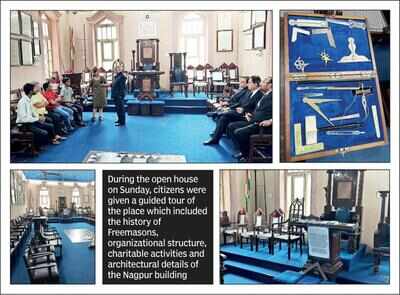- News
- City News
- nagpur News
- ‘Bhoot bangla’ no more: Freemasons dispel myths about arcane Civil Lines building
‘Bhoot bangla’ no more: Freemasons dispel myths about arcane Civil Lines building

Nagpur: For decades in Nagpur, a British-era building across the road from the high court on a quaint wooded land at Civil Lines has conjured myths and horror stories among citizens. ‘Bhoot bangla’ is how generations of Nagpurians have referred to the building called the Masonic Lodge, that was built in 1904.
But on Sunday, the Freemasons propelled their public outreach campaign by hosting an open house. Citizens were welcomed and given a guided tour of the place, with every question answered and every myth dispelled.
Ramesh Bhambani, a Freemasons past master, said, “It was probably natural for people to think of us as a secret society. Imagine that almost 120 years ago, you saw a group of people wearing black/white uniforms, heading into a building to hold a meeting after sunset with candles and fire torches. What else would an outsider imagine?”
The candles and fire torches were used because there was no electricity and on top of that, the location was secluded then and wooded. All these things put together were enough to work up a creative imagination.
As decades passed, the rumours turned into beliefs and people stayed away.
Bhambani said outsiders did not come and inquire. “Maybe that’s why our predecessors did not provide information. You also have to understand that mass communication in that era was not so easy. For people to understand what we stand for required them to be open minded,” he added.
Freemasonry is a worldwide organization whose interaction with society is through charitable acts. From funding education to distributing ration kits and medical supplies, Freemasons have been at the forefront during times of need.
While the history of Freemasonry is very long and its undocumented origins date back thousands of years, the traceable journey starts from England in the early 1700s. Bhambani said, “The British then established Masonic Lodges across the world and that’s how it came to India. In Nagpur its first location was in Kamptee, that was established in the 1860s. But since many members were living in Nagpur city, the commute to Kamptee and late-night meetings were not a viable option. And that’s how it was set up in Nagpur in 1904.”
Freemasons are in a way similar to global social organizations like Rotary International, with multiple offshoots that are affiliated to a main unit. Just like such organizations, Freemasons have their hierarchy and induct new members regularly. In Nagpur, there are around 800 Freemasons.
Then what sets Freemasons apart from other similar social organizations? Their rituals steeped in tradition and core principles centred around God, they say.
The first question probable members are asked is whether they believe in God, Bhambani said, adding, “We strongly believe in a supreme being that has created the world.”
The Freemason’s Hall, which is referred to as a temple, has holy books of all major religions found in India. “These holy books are kept right at the front when we invoke God before starting any meeting,” said Bhambani. But Freemasons have ensured that their personal religious belief are never brought into conflict. “Respect for all religions is a must for Freemasons,” he added.
The rituals also include adhering to a strict dress code while entering the hall. “It’s a black suit and tie, or a black bandhgala (Jodhpuri suit),” said Bhambani. Meeting once every month, the Freemasons take stock of charitable and organizational activities.
“There’s no secret stuff happening in our meetings,” laughs Bhambani, as he tries to dispel the myths about his parent organization. All around the hall, his brothers (as members are referred to) happily provide a guided tour to a stream of people entering the premises.
“For the last few years we have invited many outsider groups to visit our premises, but today is the first walk-in open house for the general public. Everyone is free to enter, see and understand what we do,” Bhambani said.
The guided tour included the history of Freemasons, organizational structure, charitable activities and architectural details of the Nagpur building.
But on Sunday, the Freemasons propelled their public outreach campaign by hosting an open house. Citizens were welcomed and given a guided tour of the place, with every question answered and every myth dispelled.
Ramesh Bhambani, a Freemasons past master, said, “It was probably natural for people to think of us as a secret society. Imagine that almost 120 years ago, you saw a group of people wearing black/white uniforms, heading into a building to hold a meeting after sunset with candles and fire torches. What else would an outsider imagine?”
The candles and fire torches were used because there was no electricity and on top of that, the location was secluded then and wooded. All these things put together were enough to work up a creative imagination.
As decades passed, the rumours turned into beliefs and people stayed away.
Bhambani said outsiders did not come and inquire. “Maybe that’s why our predecessors did not provide information. You also have to understand that mass communication in that era was not so easy. For people to understand what we stand for required them to be open minded,” he added.
Freemasonry is a worldwide organization whose interaction with society is through charitable acts. From funding education to distributing ration kits and medical supplies, Freemasons have been at the forefront during times of need.
While the history of Freemasonry is very long and its undocumented origins date back thousands of years, the traceable journey starts from England in the early 1700s. Bhambani said, “The British then established Masonic Lodges across the world and that’s how it came to India. In Nagpur its first location was in Kamptee, that was established in the 1860s. But since many members were living in Nagpur city, the commute to Kamptee and late-night meetings were not a viable option. And that’s how it was set up in Nagpur in 1904.”
Freemasons are in a way similar to global social organizations like Rotary International, with multiple offshoots that are affiliated to a main unit. Just like such organizations, Freemasons have their hierarchy and induct new members regularly. In Nagpur, there are around 800 Freemasons.
Then what sets Freemasons apart from other similar social organizations? Their rituals steeped in tradition and core principles centred around God, they say.
The first question probable members are asked is whether they believe in God, Bhambani said, adding, “We strongly believe in a supreme being that has created the world.”
The Freemason’s Hall, which is referred to as a temple, has holy books of all major religions found in India. “These holy books are kept right at the front when we invoke God before starting any meeting,” said Bhambani. But Freemasons have ensured that their personal religious belief are never brought into conflict. “Respect for all religions is a must for Freemasons,” he added.
The rituals also include adhering to a strict dress code while entering the hall. “It’s a black suit and tie, or a black bandhgala (Jodhpuri suit),” said Bhambani. Meeting once every month, the Freemasons take stock of charitable and organizational activities.
“There’s no secret stuff happening in our meetings,” laughs Bhambani, as he tries to dispel the myths about his parent organization. All around the hall, his brothers (as members are referred to) happily provide a guided tour to a stream of people entering the premises.
“For the last few years we have invited many outsider groups to visit our premises, but today is the first walk-in open house for the general public. Everyone is free to enter, see and understand what we do,” Bhambani said.
The guided tour included the history of Freemasons, organizational structure, charitable activities and architectural details of the Nagpur building.
FOLLOW US ON SOCIAL MEDIA
FacebookTwitterInstagramKOO APPYOUTUBE
Start a Conversation
end of article










